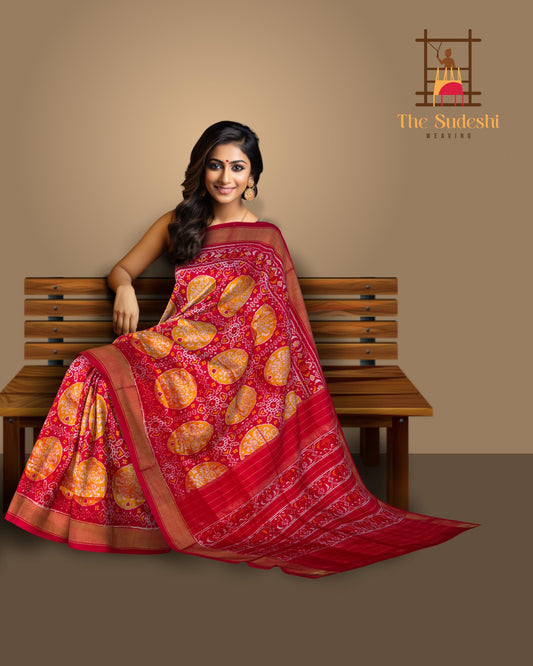Preserving Cultural Heritage: The Timeless Art of Patola Sarees
In the vibrant tapestry of India's cultural heritage, Patola sarees stand out as a symbol of intricate craftsmanship and enduring tradition. These exquisite textiles, known for their vibrant colors and geometric patterns, are not just pieces of fabric but embodiments of a rich cultural legacy. This blog explores the profound role of Patola sarees in preserving cultural heritage, their significance as symbols of cultural identity, the efforts to document and sustain this ancient craft, and the pivotal role of cultural institutions and museums in keeping this tradition alive.
The Role of Patola Sarees in Preserving Heritage
Historical Significance
Patola sarees originate from Patan, Gujarat, and their history dates back to the 12th century. Traditionally woven by the Salvi community, these sarees were once coveted by royalty and aristocracy. The double ikat technique, which involves dyeing the warp and weft threads before weaving, is a testament to the high level of skill and precision required. This age-old technique, passed down through generations, is a living link to India's historical and cultural past.
Cultural Continuity
Wearing a Patola saree is not just a fashion statement but a celebration of cultural continuity. Each saree tells a story, with motifs inspired by religious symbols, nature, and daily life. These motifs have remained unchanged for centuries, preserving a visual language that connects the present with the past. By wearing and cherishing Patola sarees, people actively participate in the preservation of their cultural heritage.
Patola Sarees as a Symbol of Cultural Identity
Symbolic Motifs and Patterns
The motifs and patterns on Patola sarees are laden with cultural significance. Common motifs include the Nari Kunjar (dancing girl), Navratna (nine gems), and Pan Bhat (leaf pattern). Each of these motifs holds specific meanings and represents various aspects of life, spirituality, and nature. By incorporating these symbols into daily attire, individuals reinforce their cultural identity and express their connection to their heritage.
Regional Pride
Patola sarees are a source of immense pride for the people of Gujarat. They symbolize regional identity and craftsmanship unique to the region. Wearing a Patola saree at weddings, festivals, and other significant events is a way of showcasing and celebrating this rich cultural heritage. The sarees are often passed down as heirlooms, further cementing their role in familial and cultural continuity.
Efforts to Document and Preserve the Craft
Government Initiatives
Recognizing the cultural and historical value of Patola sarees, the Indian government has taken several initiatives to document and preserve this craft. The Geographical Indication (GI) tag granted to Patola sarees ensures that only sarees produced in the Patan region can be labeled as Patola, protecting the authenticity and heritage of the craft. Additionally, various schemes and grants have been introduced to support the weavers and promote their work.
Educational Programs and Workshops
Numerous educational programs and workshops aim to teach the younger generation the art of Patola weaving. By involving schools, colleges, and local communities, these programs ensure that the knowledge and skills required for Patola weaving are passed on to future generations. These initiatives also create awareness about the cultural importance of Patola sarees, encouraging more people to take an active interest in preserving this heritage.
Digital Documentation
In the digital age, documenting Patola sarees through online platforms, virtual museums, and social media has become crucial. Detailed documentation, including high-resolution images, videos of the weaving process, and interviews with artisans, helps preserve the knowledge and skills associated with Patola sarees. This digital archive serves as a valuable resource for researchers, enthusiasts, and future generations.
The Role of Cultural Institutions and Museums
Showcasing Patola Sarees
Museums and cultural institutions play a vital role in preserving and promoting Patola sarees. By showcasing these textiles in exhibitions, they highlight the historical and cultural significance of the craft. Museums often collaborate with artisans to create displays that demonstrate the intricate weaving process, allowing visitors to appreciate the skill and effort involved in creating each saree.
Research and Preservation
Cultural institutions conduct research to document the history and evolution of Patola sarees. By preserving old and rare Patola sarees in their collections, they ensure that these valuable artifacts are protected for future generations. This research also contributes to a deeper understanding of the cultural and social contexts in which these sarees were created and used.
Promoting Awareness
Through educational programs, workshops, and exhibitions, cultural institutions raise awareness about the importance of preserving traditional crafts like Patola sarees. They engage with local communities, schools, and the general public to foster an appreciation for this heritage. By promoting the cultural value of Patola sarees, these institutions encourage more people to support and participate in the preservation efforts.
Conclusion
Patola sarees are more than just exquisite pieces of clothing; they are a testament to India's rich cultural heritage and craftsmanship. By understanding their historical significance, symbolic value, and the efforts to document and preserve this craft, we can appreciate the vital role they play in preserving cultural heritage. The combined efforts of artisans, the government, educational institutions, and cultural organizations ensure that the tradition of Patola sarees continues to thrive, connecting the past with the present and future generations. Through these efforts, the timeless art of Patola sarees will remain a cherished symbol of cultural identity and heritage.







Leave a comment
Please note, comments need to be approved before they are published.